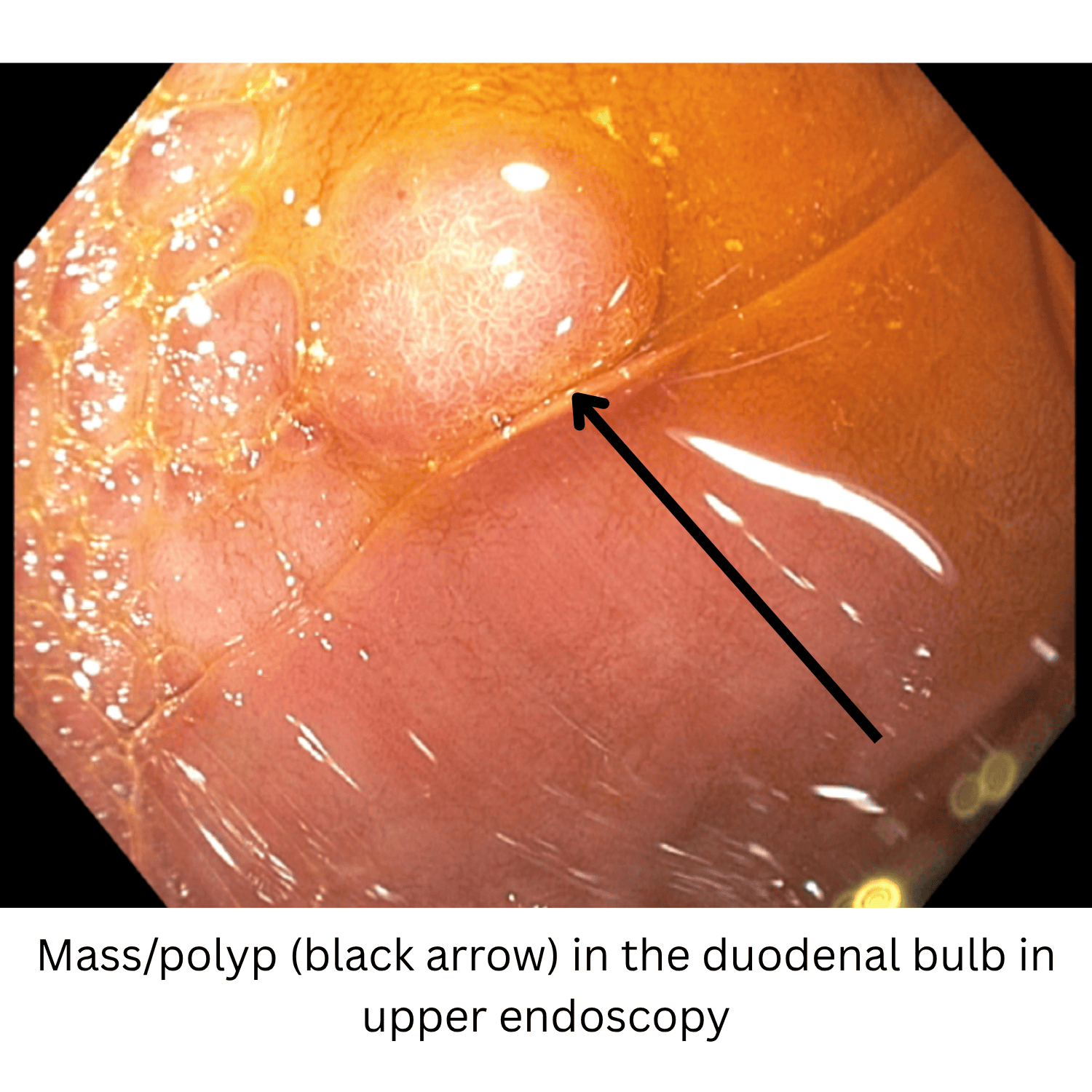Tuesday Poster Session
Category: Small Intestine
P6289 - From Syncope to Diagnosis: The Unexpected Duodenal Neuroendocrine Tumor in an Elderly
Tuesday, October 28, 2025
10:30 AM - 4:00 PM PDT
Location: Exhibit Hall
- AK
Alizay Khan, MD (she/her/hers)
Ascension Saint Joseph Hospital
Chicago, IL
Presenting Author(s)
Alizay Khan, MD1, Mohamed A. Ebrahim, MD1, Furqan Ahmed, MD1, Muhammad Sohaib Alvi, MBBS, MD1, Taha Bin Arif, MBBS, MD2
1Ascension Saint Joseph Hospital, Chicago, IL; 2Sinai Hospital of Baltimore, The George Washington University Regional Medical Campus, Baltimore, MD
Introduction: Neuroendocrine tumors (NETs) have been increasing in incidence due to higher rates of endoscopic evaluation. They constitute 2% of all gastrointestinal malignancies. They are more prevalent in females. NETS most commonly develop in the small intestine. They are mostly non-functional, although a considerable proportion secrete gastric acid and in turn, can cause duodenal ulceration. Carcinoid syndrome is rare in duodenal NETs and mostly occurs in the setting of hepatic metastases.
Case Description/
Methods: A 78-year-old male with a history of hypertension, hyperlipidemia, diabetes mellitus, paroxysmal atrial fibrillation on apixaban, and left lower extremity weakness due to childhood polio presented to the emergency department following an episode of syncope. He reported intermittent melena for the past 2-3 months but denied hematemesis or hematochezia. Initial labs showed stable hemoglobin (14.3 g/dL) and platelets (249,000/μL), but he had hypokalemia (2.8 mmol/L) and atrial fibrillation with rapid ventricular response on EKG. Given his melena and anticoagulation use, gastroenterology was consulted for further evaluation. During upper endoscopy, a 6 cm x 6 cm polyp was found in the duodenal bulb. Its appearance was benign, but due to the size and location being atypical, a biopsy was obtained. Biopsy confirmed a well-differentiated duodenal neuroendocrine tumor (DNET), with staining positive for synaptophysin, chromogranin, CD56 and focally AE 1/3. Imaging showed no distant metastases. Initially, the patient's syncope was attributed to arrhythmia secondary to hypokalemia rather than DNET. Given his age and comorbidities, he was managed conservatively along with close surveillance and was given follow-up with an advanced endoscopist and hematology/oncology.
Discussion: This case highlights an unusual presentation of NET in an elderly patient with multiple comorbidities, emphasizing the importance of endoscopic evaluation in unexplained gastrointestinal bleeding, even in the absence of anemia. Occupational risk factors, including smoking and coal mine exposure, may have contributed to his malignancy. Further studies are needed to explore NETs in elderly populations.

Figure: Polyp in the duodenal bulb
Disclosures:
Alizay Khan indicated no relevant financial relationships.
Mohamed Ebrahim indicated no relevant financial relationships.
Furqan Ahmed indicated no relevant financial relationships.
Muhammad Sohaib Alvi indicated no relevant financial relationships.
Taha Bin Arif indicated no relevant financial relationships.
Alizay Khan, MD1, Mohamed A. Ebrahim, MD1, Furqan Ahmed, MD1, Muhammad Sohaib Alvi, MBBS, MD1, Taha Bin Arif, MBBS, MD2. P6289 - From Syncope to Diagnosis: The Unexpected Duodenal Neuroendocrine Tumor in an Elderly, ACG 2025 Annual Scientific Meeting Abstracts. Phoenix, AZ: American College of Gastroenterology.
1Ascension Saint Joseph Hospital, Chicago, IL; 2Sinai Hospital of Baltimore, The George Washington University Regional Medical Campus, Baltimore, MD
Introduction: Neuroendocrine tumors (NETs) have been increasing in incidence due to higher rates of endoscopic evaluation. They constitute 2% of all gastrointestinal malignancies. They are more prevalent in females. NETS most commonly develop in the small intestine. They are mostly non-functional, although a considerable proportion secrete gastric acid and in turn, can cause duodenal ulceration. Carcinoid syndrome is rare in duodenal NETs and mostly occurs in the setting of hepatic metastases.
Case Description/
Methods: A 78-year-old male with a history of hypertension, hyperlipidemia, diabetes mellitus, paroxysmal atrial fibrillation on apixaban, and left lower extremity weakness due to childhood polio presented to the emergency department following an episode of syncope. He reported intermittent melena for the past 2-3 months but denied hematemesis or hematochezia. Initial labs showed stable hemoglobin (14.3 g/dL) and platelets (249,000/μL), but he had hypokalemia (2.8 mmol/L) and atrial fibrillation with rapid ventricular response on EKG. Given his melena and anticoagulation use, gastroenterology was consulted for further evaluation. During upper endoscopy, a 6 cm x 6 cm polyp was found in the duodenal bulb. Its appearance was benign, but due to the size and location being atypical, a biopsy was obtained. Biopsy confirmed a well-differentiated duodenal neuroendocrine tumor (DNET), with staining positive for synaptophysin, chromogranin, CD56 and focally AE 1/3. Imaging showed no distant metastases. Initially, the patient's syncope was attributed to arrhythmia secondary to hypokalemia rather than DNET. Given his age and comorbidities, he was managed conservatively along with close surveillance and was given follow-up with an advanced endoscopist and hematology/oncology.
Discussion: This case highlights an unusual presentation of NET in an elderly patient with multiple comorbidities, emphasizing the importance of endoscopic evaluation in unexplained gastrointestinal bleeding, even in the absence of anemia. Occupational risk factors, including smoking and coal mine exposure, may have contributed to his malignancy. Further studies are needed to explore NETs in elderly populations.

Figure: Polyp in the duodenal bulb
Disclosures:
Alizay Khan indicated no relevant financial relationships.
Mohamed Ebrahim indicated no relevant financial relationships.
Furqan Ahmed indicated no relevant financial relationships.
Muhammad Sohaib Alvi indicated no relevant financial relationships.
Taha Bin Arif indicated no relevant financial relationships.
Alizay Khan, MD1, Mohamed A. Ebrahim, MD1, Furqan Ahmed, MD1, Muhammad Sohaib Alvi, MBBS, MD1, Taha Bin Arif, MBBS, MD2. P6289 - From Syncope to Diagnosis: The Unexpected Duodenal Neuroendocrine Tumor in an Elderly, ACG 2025 Annual Scientific Meeting Abstracts. Phoenix, AZ: American College of Gastroenterology.
